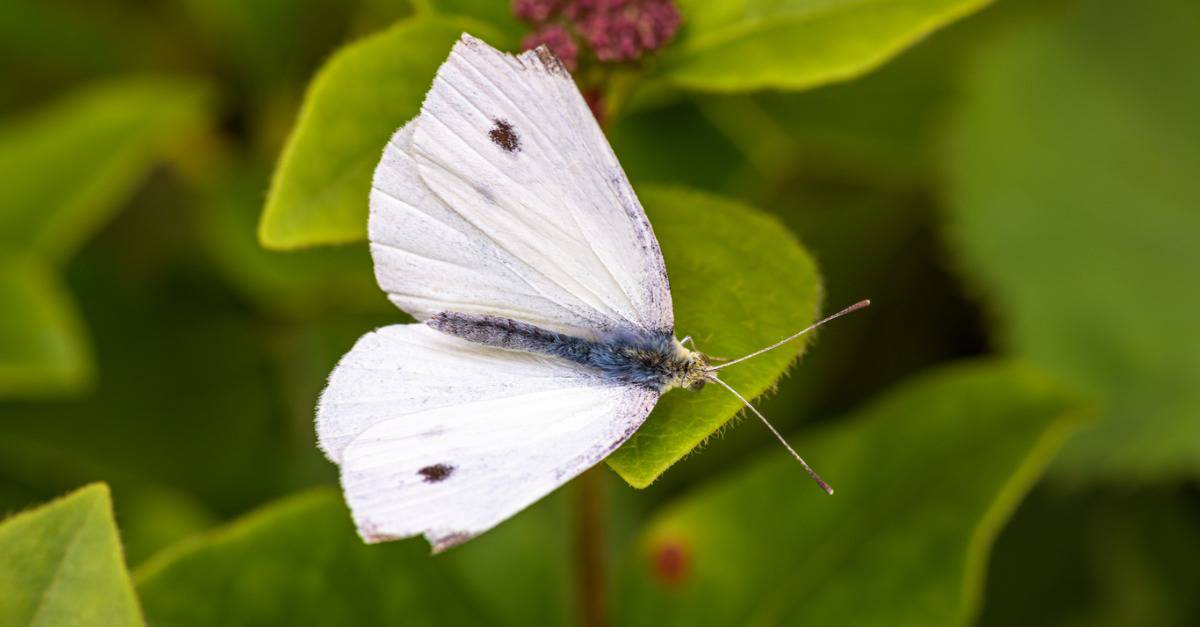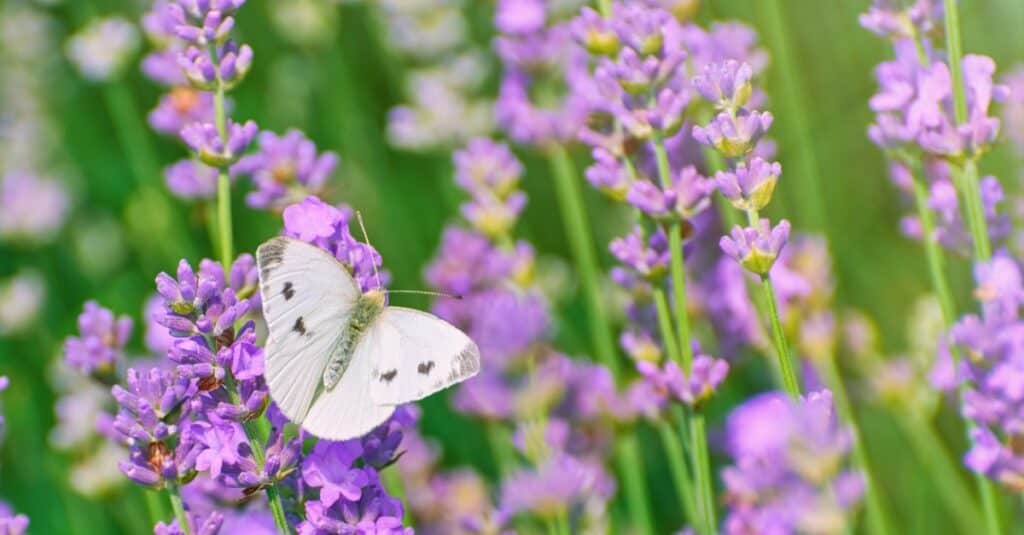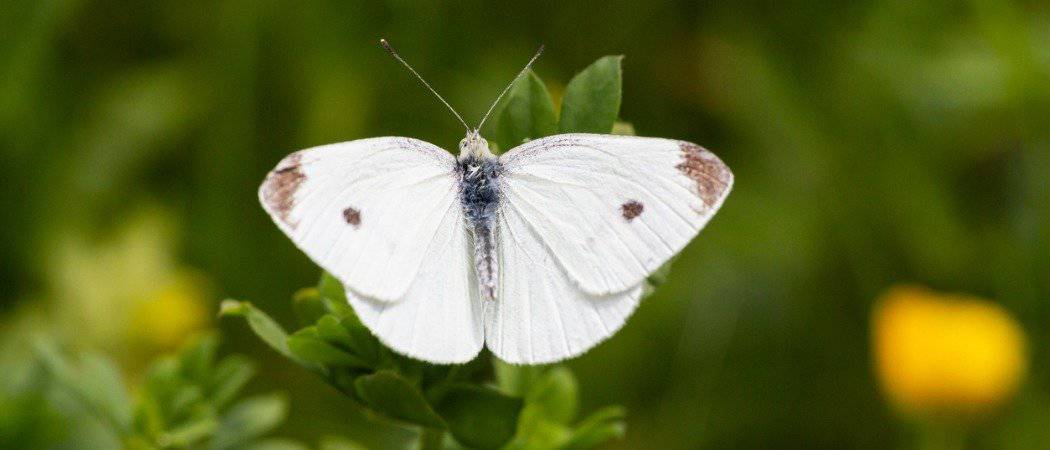White Butterfly
Pieris rapae
This butterfly determines the smell and taste of a flower with its feet.
Advertisement
White Butterfly Scientific Classification
- Kingdom
- Animalia
- Phylum
- Arthropoda
- Class
- Insecta
- Order
- Lepidoptera
- Family
- Pieridae
- Genus
- Pieris
- Scientific Name
- Pieris rapae
Read our Complete Guide to Classification of Animals.
White Butterfly Conservation Status
White Butterfly Facts
- Prey
- nectar
- Name Of Young
- Eggs, larva, pupa
- Group Behavior
- Solitary
- Fun Fact
- This butterfly determines the smell and taste of a flower with its feet.
- Biggest Threat
- Loss of habitat
- Most Distinctive Feature
- Bright, white wings
- Other Name(s)
- Cabbage white butterfly
- Gestation Period
- Approximately 10 days
- Wingspan
- 1 ¾ to 2 ¼ inches
- Litter Size
- 40-100 egss
- Habitat
- Gardens, weedy areas, forests
- Diet
- Herbivore
- Type
- insect
- Common Name
- white butterfly
- Number Of Species
- 1100
- Location
- North America, Africa, Asia, Australia, Europe
- Group
- solitary
White Butterfly Physical Characteristics
- Color
- Grey
- Black
- White
- Orange
- Skin Type
- Exoskeleton
- Lifespan
- 2-3 weeks
- Weight
- less than one ounce
- Length
- 1-2 inches
- Age of Sexual Maturity
- As adult emerging from chrysalis
- Age of Weaning
- Immediately
View all of the White Butterfly images!
“They are called cabbage white butterflies because they eat cabbage leaves while the caterpillar stage of life.”
The white butterfly lives all over the world including Australia, Asia, and Europe. There are a total of 1,100 species of white butterflies worldwide. They are found in gardens, forests, and traveling over fields of weeds. Their bright, white wings and black spots make them hard to miss! They survive on a diet of nectar from flowers or pieces of fruit. This butterfly is known as the cabbage white butterfly in North America.
4 Incredible White Butterfly Facts!
- This insect has special sensors on its feet that tell it whether a flower has nectar.
- These insects have a wide range of symbolism attached to them. They can symbolize good luck, an upcoming rainy season, or even death.
- The cabbage white butterfly was introduced to the United States back in the mid-1800s.
- A male gets the attention of a female cabbage white butterfly by flying in a zigzag motion.

Scientific Names
The white butterfly belongs to the Pieridae family of which there are 1,100 species of white butterflies. The Pierdiae is part of the larger and more vast order Lepidoptera, of which there can be found around 180,000 species.
Types Of

Four types of white butterflies are commonly seen in gardens,
©iStock.com/Patrick Herzberg
A few types of white butterflies commonly seen in gardens include:
- Green-veined white butterfly (Pieris napi) – Streaked (greeny-grey lines following the wing veins radiating out towards the wing’s outer edge)
- Large white butterfly (Pieris Brassicae) – Plain (a creamy-white color, no obvious markings)
- Small white butterfly (Pieris rapae) – Plain (a creamy-white color, no obvious markings)
- Orange-tip white butterfly (Anthocharis cardamines) – Blotchy (greeny-grey camouflage pattern all over the wing); males have bright orange wing-tips.
Evolution And Origin
It is believed that the butterfly’s ancestors evolved simultaneously as flowering plants. Its oldest common ancestor, the moth, in the order Lepidoptera, was present about 300 million years ago, during the Carboniferous Period. However, butterflies didn’t begin to evolve from moths until 100 million years ago and the most contributing factor to this change was due to natural selection in the way they were able to eat. Since moths had developed straw-like jaws, they were able to profit from the natural food source of the nectar from the plants and flowers, eventually leading the change from moth to butterfly.
Appearance

The white butterfly appears to be pure white but has distinct markings.
©Robert Biedermann/Shutterstock.com
The cabbage white butterfly has a wingspan of 1 ¾ to 2 ¼ inches. Though at first glance it looks to have pure white wings, the underside of its forewing and hindwings are pale yellow. Both males and females have black spots on their wings, but there’s a difference. A male has one black spot on its forewing while a female has two.
They have two antennae with a club or a black tip at the end of each one. Their body has three sections: head, thorax, and abdomen. They have six legs, four long ones, and two short ones. When comparing a white butterfly to a white moth, you’ll see the moth is smaller. A white moth has a smaller wingspan.
The largest of this species is the Large white butterfly with a wingspan of up to 2.7 inches.
Camouflage is one way this insect protects itself against predators. Of course, this is a bright, white butterfly, so it would have to find a gathering of white flowers to blend in. One of the types of white butterflies, namely the green-veined white, can blend in a little easier with flowers and plants that are both green and white.
The cabbage white butterfly is solitary unless it’s breeding time. Occasionally, they can be found flying near other white butterflies.
Habitat

©iStock.com/Rocter
White butterflies are originally from Europe. But, they have spread to other places around the world such as Australia, Asia, Africa, and North America.
Some cabbage white butterflies are partial to a garden habitat. Others are seen traveling through weeds near roadsides and in parks. Forests are another habitat for these adaptable insects. If they find their way inside a home, it’s purely by accident.
Diet

White butterflies have a proboscis which is like a slim drinking staw, used for bringing liquid into their bodies.
©iStock.com/Maya Jane
White butterflies don’t have a mouth, so they don’t chew food. Instead, they have a proboscis which is like a slim drinking straw they use to draw liquid into their body. They spend most of their day moving from flower to flower to get nourishment.
What Eats White Butterflies?
Spiders, birds, and wasps are among the predators of white butterflies. All three of these predators live in a habitat close by.
What Do White Butterflies Eat?
Cabbage white butterflies drink nectar from flowers or fruit as sustenance. The butterfly lands on a flower and uses the sensors in its feet and antennae to determine whether the plant has the type of nectar it wants to drink. This is one of the ways it protects itself from taking in liquid that’s dangerous to its health.
Prevention

White butterflies have the potential to cause problems in gardens.
©iStock.com/fz750
While these butterflies aren’t a pest inside a home, they can be pests in a homeowner’s garden. Though a butterfly moving through a garden and drinking nectar is harmless, they have the potential to create a problem. In short, these butterflies may lay eggs. The eggs hatch into cabbageworms. These cabbageworms eat a lot of items in a garden including cauliflower, broccoli, kale, and, of course, cabbage. If a gardener doesn’t see actual cabbageworms, there is clear evidence of their presence. These pests make tiny holes and tears throughout the leaves of cabbage and other vegetable plants.
To get rid of cabbageworms, some people go through and look for eggs left behind by butterflies so they can remove them. These butterflies lay their eggs on the underside of the leaves of cabbage and other plants. Cabbageworm eggs are oblong, yellow, and about one millimeter long. Look closely enough and you’ll notice there are ridges on the sides of the eggs. There can be large clusters of them located under a leaf. The female butterfly lays the eggs there purposely, so the cabbageworms will have plenty to eat!
Another way to get rid of cabbageworms is with cornmeal. When a cabbage plant is wet, sprinkle it with cornmeal. The cabbageworms overeat the cornmeal and die. Putting up special butterfly netting can also prevent cabbage white butterflies from getting close enough to a garden to lay eggs. Plus, the netting doesn’t capture the butterflies. They just move on.
View all 108 animals that start with WWhite Butterfly FAQs (Frequently Asked Questions)
What is the meaning of a white butterfly?
There’s a wide range of symbolism attached to the white butterfly. One meaning they carry with them is good luck. This is supposed to be especially true when one is seen near the beginning of a new year.
Another meaning these insects carry with them points to the threat of rain. When one appears it’s a sign of a coming rainstorm.
The symbolism of this butterfly is also connected to death. According to some groups, it’s a bad omen to see this butterfly.
Are white butterflies bad for your garden?
Yes and no. A white butterfly that visits a garden to drink nectar from flowers doesn’t pose any harm to the plants. But, when a white butterfly lays eggs, it can become a problem.
The eggs transform into cabbageworms. Cabbageworms are notorious for their plant-eating activity. They eat cabbage, broccoli, kale, and cauliflower plants. Their vegetable diet can easily kill the bulk of the material in a garden. Someone who goes to the trouble to plant a vegetable garden is definitely not going to want cabbageworms anywhere near it.
What kinds of butterflies are white?
There are 1,100 species of a white butterfly. There are 60 species in North America alone. The largely white, small white, and green-veined white butterfly are just a few of the many types.
What is the difference between a white butterfly and a moth?
As a matter of fact, there are lots of differences between these two insects. In terms of appearance, white butterflies have long thin antennae with a club at the end of each. Alternatively, a white moth has feathery and short antennae.
These butterflies have a proboscis and moths do not. Though they are both small, a white moth is smaller than a white butterfly.
The next time you see a white moth resting on a wall check out its posture. While white moths rest with their wings spread out, white butterflies rest on a flower with their wings folded upward.
While white moths are active at night, white butterflies are out and looking for food during the daytime.
Thank you for reading! Have some feedback for us? Contact the AZ Animals editorial team.
Sources
- Butterfly Conservation / Accessed October 11, 2021
- biointerstingfacts / Accessed October 11, 2021
- University of Kentucky / Accessed October 11, 2021
- Wikipedia / Accessed October 11, 2021
- Butterfly Insight / Accessed October 11, 2021
- Florida Museum / Published October 21, 2019 / Accessed March 25, 2023
- (1970)


















